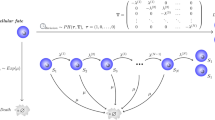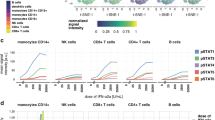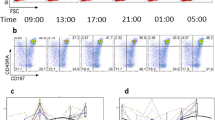Abstract
Cellular proliferation is an essential feature of the adaptive immune response. The introduction of the division tracking dye carboxyfluorescein diacetate succinimidyl ester (CFSE) has made it possible to monitor the number of cell divisions during proliferation and to examine the relationship between proliferation and differentiation. Although qualitative examination of CFSE data may be useful, substantially more information about division and death rates can be extracted from quantitative CFSE time-series experiments. Quantitative methods can reveal in detail how lymphocyte proliferation and survival are regulated and altered by signals such as those received from co-stimulatory molecules, drugs and genetic polymorphisms. In this protocol, we present a detailed method for examining time-series data using graphical and computer-based procedures available to all experimenters.
This is a preview of subscription content, access via your institution
Access options
Subscribe to this journal
Receive 12 print issues and online access
$259.00 per year
only $21.58 per issue
Buy this article
- Purchase on Springer Link
- Instant access to full article PDF
Prices may be subject to local taxes which are calculated during checkout




Similar content being viewed by others
References
Denizot, F. & Lang, R. Rapid colorimetric assay for cell growth and survival. Modifications to the tetrazolium dye procedure giving improved sensitivity and reliability. J. Immunol. Methods 89, 271–277 (1986).
Mosmann, T. Rapid colorimetric assay for cellular growth and survival: application to proliferation and cytotoxicity assays. J. Immunol. Methods 65, 55–63 (1983).
Gett, A.V. & Hodgkin, P.D. A cellular calculus for signal integration by T cells. Nat. Immunol. 1, 239–244 (2000).
Good, K.L., Bryant, V.L. & Tangye, S.G. Kinetics of human B cell behavior and amplification of proliferative responses following stimulation with IL-21. J. Immunol. 177, 5236–5247 (2006).
Deenick, E.K., Gett, A.V. & Hodgkin, P.D. Stochastic model of T cell proliferation: a calculus revealing IL-2 regulation of precursor frequencies, cell cycle time, and survival. J. Immunol. 170, 4963–4972 (2003).
Hommel, M. & Hodgkin, P.D. TCR affinity promotes CD8+ T cell expansion by regulating survival. J. Immunol. 179, 2250–2260 (2007).
De Boer, R.J. & Perelson, A.S. Estimating division and death rates from CFSE data. J. Comp. Appl. Math. 184, 104–164 (2005).
De Boer, R.J., Ganusov, V.V., Milutinovic, D., Hodgkin, P.D. & Perelson, A.S. Estimating lymphocyte division and death rates from CFSE data. Bull. Math. Biol. 68, 1011–1031 (2006).
Pilyugin, S.S., Ganusov, V.V., Murali-Krishna, K., Ahmed, R. & Antia, R. The rescaling method for quantifying the turnover of cell populations. J. Theor. Biol. 225, 275–283 (2003).
Hawkins, E.D., Turner, M.L., Dowling, M.R., van Gend, C. & Hodgkin, P.D. A model of immune regulation as a consequence of randomized lymphocyte division and death times. Proc. Natl. Acad. Sci. USA 104, 5032–5037 (2007).
Cory, S., Huang, D.C. & Adams, J.M. The Bcl-2 family: roles in cell survival and oncogenesis. Oncogene 22, 8590–8607 (2003).
Hodgkin, P.D., Lee, J.H. & Lyons, A.B. B cell differentiation and isotype switching is related to division cycle number. J. Exp. Med. 184, 277–281 (1996).
Gett, A.V. & Hodgkin, P.D. Cell division regulates the T cell cytokine repertoire, revealing a mechanism underlying immune class regulation. Proc. Natl. Acad. Sci. USA 95, 9488–9493 (1998).
Quah, B.J.C., Warren, H.S. & Parish, C.R. Monitoring lymphocyte proliferation in vitro and in vivo with the intracellular fluorescent dye carboxyfluorescein diacetate succinimidyl ester (CFSE). Nat. Protoc. 2, 2049–2056 (2007).
Ganusov, V.V. et al. Quantifying cell turnover using CFSE data. J. Immunol. Methods 298, 183–200 (2005).
Lyons, A.B. & Parish, C.R. Determination of lymphocyte division by flow cytometry. J. Immunol. Methods 171, 131–137 (1994).
Author information
Authors and Affiliations
Corresponding author
Ethics declarations
Competing interests
The authors declare no competing financial interests.
Rights and permissions
About this article
Cite this article
Hawkins, E., Hommel, M., Turner, M. et al. Measuring lymphocyte proliferation, survival and differentiation using CFSE time-series data. Nat Protoc 2, 2057–2067 (2007). https://doi.org/10.1038/nprot.2007.297
Published:
Issue Date:
DOI: https://doi.org/10.1038/nprot.2007.297
This article is cited by
-
Majority of human circulating IgG plasmablasts stop blasting in a cell-free pro-survival culture
Scientific Reports (2024)
-
Assessment of the therapeutic role of mesenchymal stromal cells in a mouse model of graft-versus-host disease using cryo-imaging
Scientific Reports (2023)
-
Dendritic epidermal T cells secreting exosomes promote the proliferation of epidermal stem cells to enhance wound re-epithelialization
Stem Cell Research & Therapy (2022)
-
Epigenetic modulators of B cell fate identified through coupled phenotype-transcriptome analysis
Cell Death & Differentiation (2022)
-
Manipulating niche composition limits damage to haematopoietic stem cells during Plasmodium infection
Nature Cell Biology (2020)
Comments
By submitting a comment you agree to abide by our Terms and Community Guidelines. If you find something abusive or that does not comply with our terms or guidelines please flag it as inappropriate.



